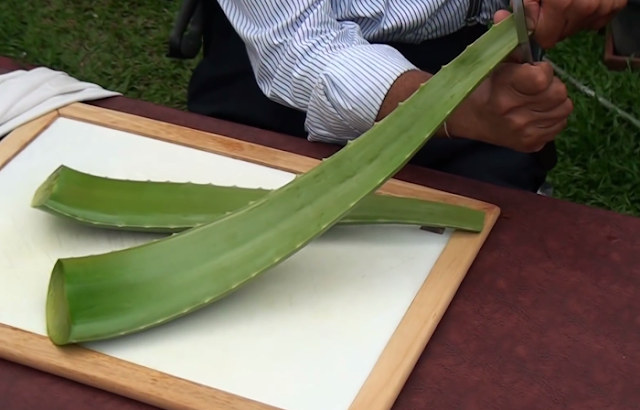In some places it is commonly called aloe vera or Aloe mabutto. Although the latter may have similar medicinal properties, at the pharmaceutical level it is important to identify the species correctly.
Currently, there are more than 250 different recognized varieties of aloe, of which only three or four have significant curative or medicinal characteristics. The most potent of these, rich in vitamins, minerals, amino acids and enzymes is the aloe arborescens.
One of the most anciently registered pharmaceutical applications can be found in an Sumerian clay tablet from the 21st century BC, but there are reports of plant drawings on the walls of Egyptian temples since the 4th millennium BC
In cosmetics it is used more and more. Most of the manufacturers responsible extract and purify the extracts avoiding the most irritating components; It is also currently used directly through very rudimentary domestic procedures, giving rise to products that can cause irritation (dermatitis, eczema) or allergic reactions (urticaria).
Currently, there are more than 250 different recognized varieties of aloe, of which only three or four have significant curative or medicinal characteristics. The most potent of these, rich in vitamins, minerals, amino acids and enzymes is the aloe arborescens.
One of the most anciently registered pharmaceutical applications can be found in an Sumerian clay tablet from the 21st century BC, but there are reports of plant drawings on the walls of Egyptian temples since the 4th millennium BC
In cosmetics it is used more and more. Most of the manufacturers responsible extract and purify the extracts avoiding the most irritating components; It is also currently used directly through very rudimentary domestic procedures, giving rise to products that can cause irritation (dermatitis, eczema) or allergic reactions (urticaria).
Culture
Industrial cultivation of Aloe vera
Aloe Vera in Pot
Because Aloe vera comes from hot and desert sites, its cultivation requires temperature above 10 degrees, below it can be damaged, as it is not cold-tolerant; It also does not tolerate excessive moisture requiring dry climates. It can be located in full sun or in shade.
Terracotta pots are preferable to any other material, since they are porous, thus avoiding excess moisture. A porous substrate, such as the one used for cactus and succulents, is suitable to allow it to dry completely before rewatering. When plants are filled with the hijuelos that arise around the "mother plant", they should be divided to enable further growth of the main plant and help prevent infestations of pests, such as mites, cochineals and aphid species. During the winter, this species can enter the latency state, so the irrigations must be suspended, especially if it is on the outside. In areas that are too cold it is better to keep it indoors or in heated glasshouses.
This species is grown on a large scale in Australia, Bangladesh, Cuba, Dominican Republic, China, Mexico, India, Jamaica, Colombia, Kenya, Tanzania and South Africa, together with the United States to supply the cosmetics industry.
Industrial cultivation of Aloe vera
Aloe Vera in Pot
Because Aloe vera comes from hot and desert sites, its cultivation requires temperature above 10 degrees, below it can be damaged, as it is not cold-tolerant; It also does not tolerate excessive moisture requiring dry climates. It can be located in full sun or in shade.
Terracotta pots are preferable to any other material, since they are porous, thus avoiding excess moisture. A porous substrate, such as the one used for cactus and succulents, is suitable to allow it to dry completely before rewatering. When plants are filled with the hijuelos that arise around the "mother plant", they should be divided to enable further growth of the main plant and help prevent infestations of pests, such as mites, cochineals and aphid species. During the winter, this species can enter the latency state, so the irrigations must be suspended, especially if it is on the outside. In areas that are too cold it is better to keep it indoors or in heated glasshouses.
This species is grown on a large scale in Australia, Bangladesh, Cuba, Dominican Republic, China, Mexico, India, Jamaica, Colombia, Kenya, Tanzania and South Africa, together with the United States to supply the cosmetics industry.
Chemical components
Inflorescence
Aloemodina: Regulates the functioning of the intestinal mucosa.
Aloeoleína: Improves duodenal and stomach ulcers. Decreases acidity.
Aloetina: neutralizes The effect of microbial toxins.
Aloin: Relieves constipation.
Amino acids: It intervenes in the formation of proteins.
Carricina: It reinforces the immune system and it would help the defenses.
Creatinine: It is essential in the reactions of storage and transmission of energy.
Emolina, Emodin, Barbaloína: They generate salicylic acid of analgesic and antifebrile effect.
Mannose phosphate: Tissue growth agent with healing effect.
Minerals: Calcium, magnesium, phosphorus, potassium, zinc, copper.
Mucilage: emollient activity on the skin.
Saponins: Antiseptic.
Phytosterols: Anti-inflammatory action.
Mucopolysaccharides: Responsible for cellular hydration.
Plant hormones: Stimulate cell growth and scarring.
Enzymes: They intervene in the stimulation of the defenses of the organism.
This post hopefully helpful.
Thank You have been willing to read..
by: https://steemit.com/cn/@ridwant/the-benefits-of-eating-aloe-vera
Inflorescence
Aloemodina: Regulates the functioning of the intestinal mucosa.
Aloeoleína: Improves duodenal and stomach ulcers. Decreases acidity.
Aloetina: neutralizes The effect of microbial toxins.
Aloin: Relieves constipation.
Amino acids: It intervenes in the formation of proteins.
Carricina: It reinforces the immune system and it would help the defenses.
Creatinine: It is essential in the reactions of storage and transmission of energy.
Emolina, Emodin, Barbaloína: They generate salicylic acid of analgesic and antifebrile effect.
Mannose phosphate: Tissue growth agent with healing effect.
Minerals: Calcium, magnesium, phosphorus, potassium, zinc, copper.
Mucilage: emollient activity on the skin.
Saponins: Antiseptic.
Phytosterols: Anti-inflammatory action.
Mucopolysaccharides: Responsible for cellular hydration.
Plant hormones: Stimulate cell growth and scarring.
Enzymes: They intervene in the stimulation of the defenses of the organism.
This post hopefully helpful.
Thank You have been willing to read..
by: https://steemit.com/cn/@ridwant/the-benefits-of-eating-aloe-vera




Post a Comment